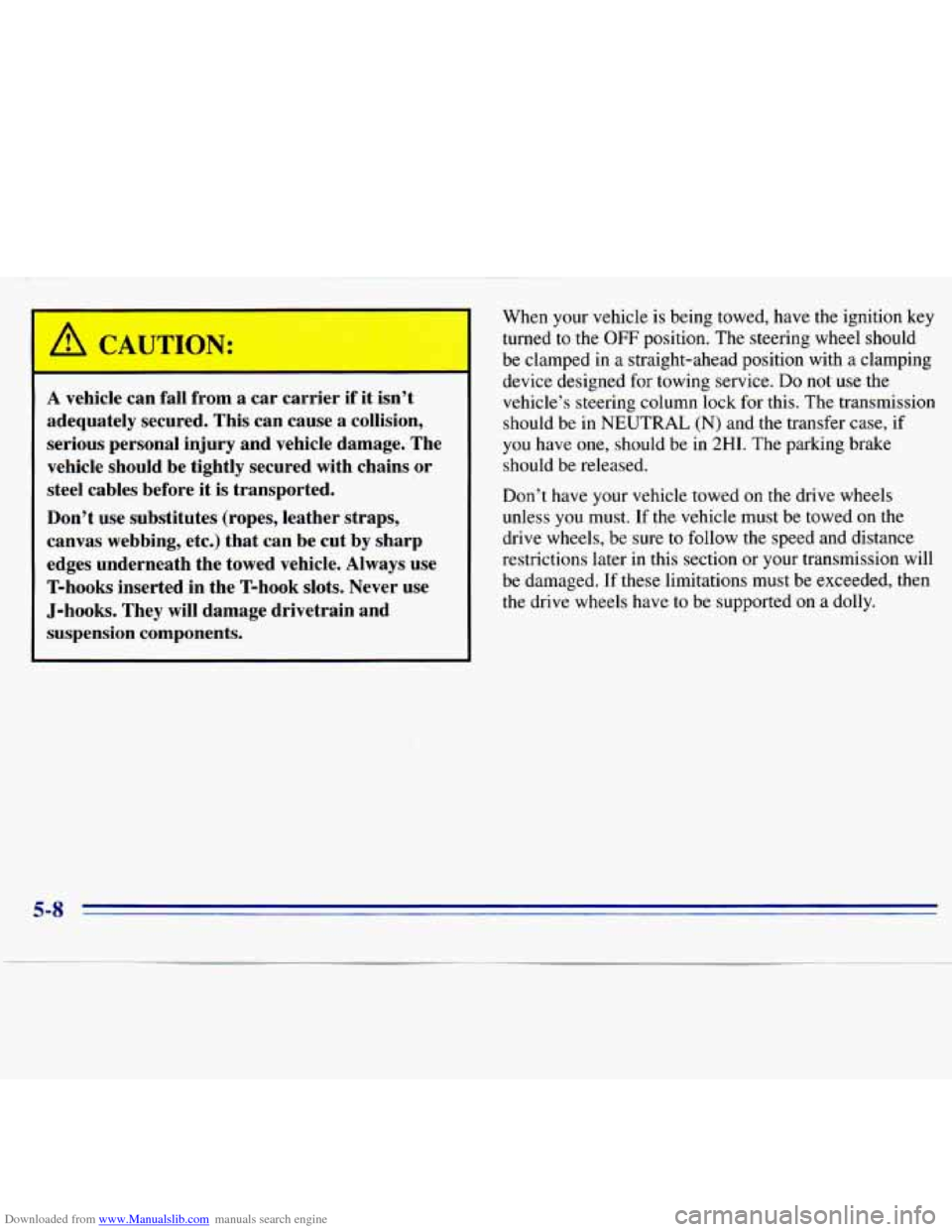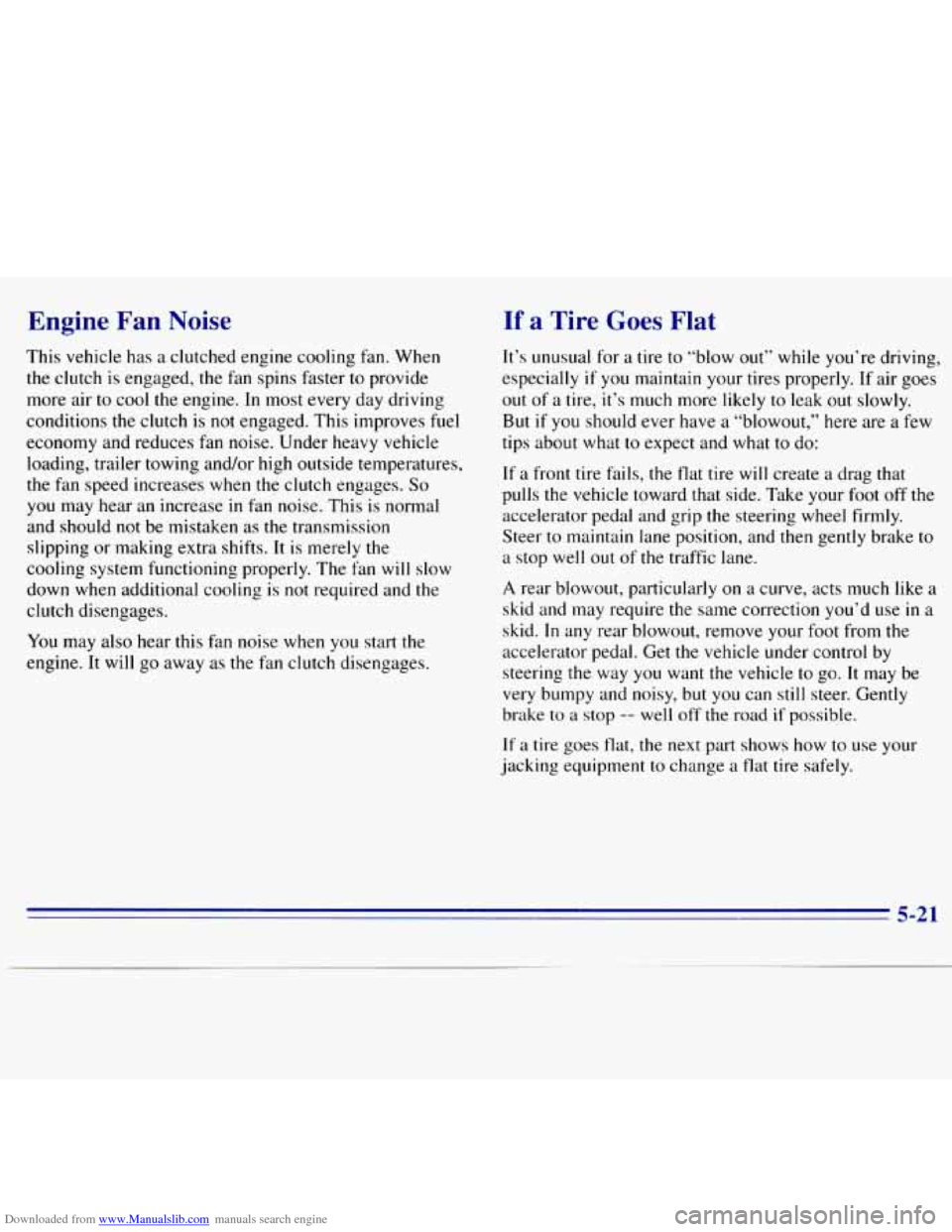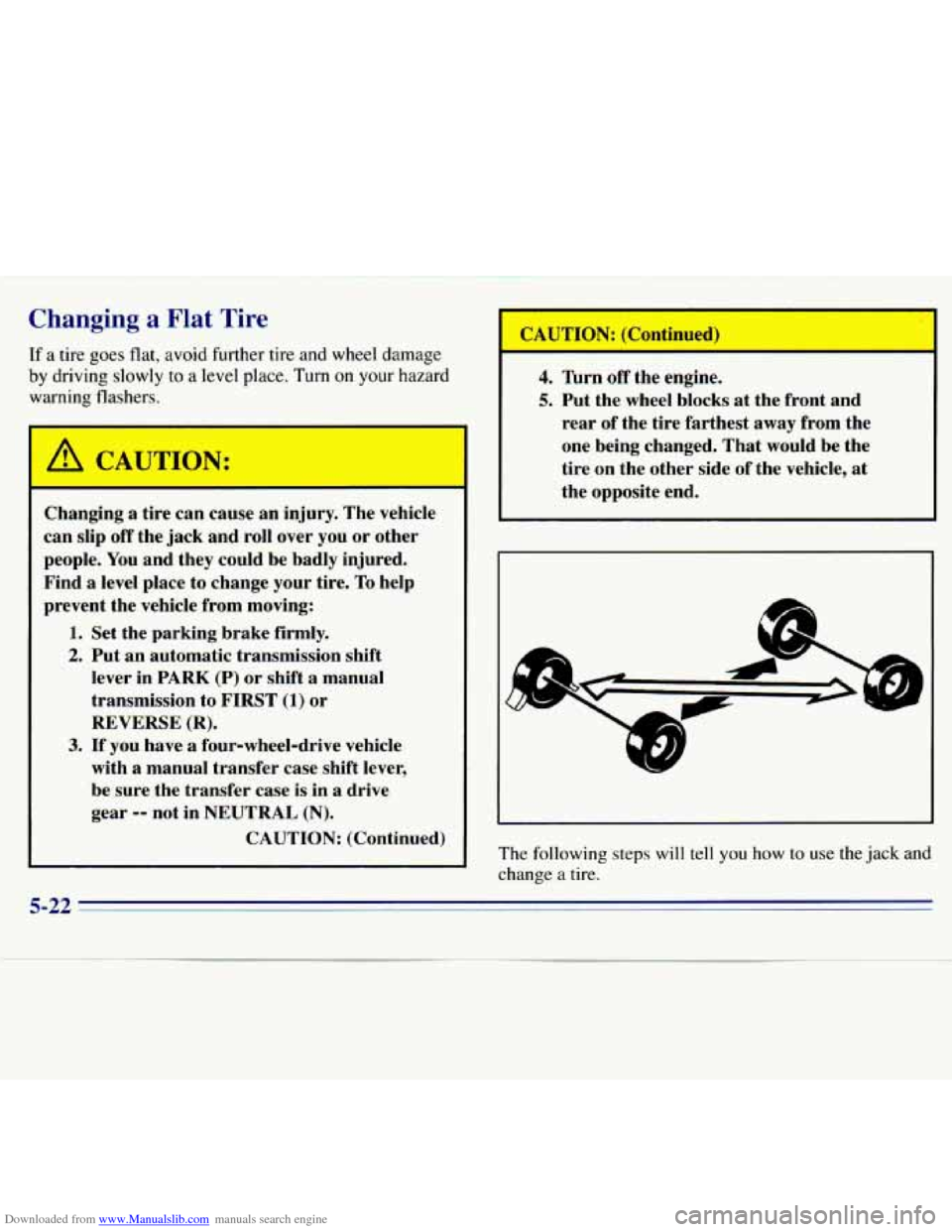Page 197 of 375

Downloaded from www.Manualslib.com manuals search engine mm
A vehicle can fall from a car carrier if it isn’t
adequately secured, This can cause a collision,
serious personal injury and vehicle damage. The
vehicle should be tightly secured with chains or
steel cables before
it is transported.
Don’t use substitutes (ropes, leather straps,
canvas webbing, etc.) that can be cut by sharp
edges underneath the towed vehicle. Always use
T-hooks inserted in the T-hook slots, Never use
J-hooks. They will damage drivetrain and
suspension components, When your vehicle
is being towed, have the ignition key
turned
to the OFF position. The steering wheel should
be clamped in a straight-ahead position with a clamping device designed for towing service.
Do not use the
vehicle’s steering column lock for this. The transmission
should be in
NEUTRAL (N) and the transfer case, if
you have one, should be in 2HI. The parking brake
should be released.
Don’t have your vehicle towed on the drive wheels
unless you must.
If the vehicle must be towed on the
drive wheels, be sure to follow the speed and distance
restrictions later in this section or your transmission will
be damaged. If these limitations must be exceeded, then
the drive wheels have
to be supported on a dolly.
5-8
Page 198 of 375
Downloaded from www.Manualslib.com manuals search engine Front Towing
Tow Limits -- 35 mph (56 km/h), 50 miles (80 km)
' Vehicles with the all-wheel-drive or.four- wheel-drive
option must
use a towing dolly under the rear wheels
when towing
from the front.
NOTICE:
Do not tow with sling-type equipment or
fascidfog lamp damage will occur. Use wheel lift
or car carrier equipment. Additional ramping
may be required for car carrier equipment. Use
safety chains and wheel straps.
Towing a vehicle over rough surfaces could
damage
a vehicle. Damage can occur from
vehicle to ground or vehicle to wheel-lift
equipment.
To help avoid damage, install a
towing dolly and raise the vehicle until adequate
clearance is obtained between the ground and/or
wheel-lift equipment.
Do not attach winch cables or J-hooks to
suspension components when using car carrier
equipment. Always use T-hooks inserted
in the
T-hook slots.
5-9
Page 199 of 375
Downloaded from www.Manualslib.com manuals search engine Front Towing
Tow Limits -- 35 mph (56 km/h), 50 miles (80 km)
' Vehicles with the all-wheel-drive or four-wheel-drive
option must
use a towing dolly under the rear wheels
when towing
from the front.
NOTICE:
Do not tow with sling-type equipment or
fascia/fog lamp damage will occur. Use wheel lift
or car carrier equipment. Additional ramping
may be required for car carrier equipment. Use
safety chains and wheel straps.
Towing
a vehicle over rough surfaces could
damage
a vehicle. Damage can occur from
vehicle to ground or vehicle to wheel-lift
equipment.
To help avoid damage, install a
towing dolly and raise the vehicle until adequate
clearance is obtained between the ground and/or
wheel-lift equipment.
Do not attach winch cables or J-hooks to
suspension components when using car carrier
equipment. Always use T-hooks inserted in the
T- hook slots.
5-9
Page 200 of 375
Downloaded from www.Manualslib.com manuals search engine Rear Towing
Tow Limits -- 35 mph (56 km/h), 50 miles (80 km)
Vehicles with the ail-wheel-drive
or four- wheel-drive
option must use
a towing dolly under the front wheels
when towing from the real:
NOTICE:
Do not tow with sling-type equipment or rear
bumper valance damage will occur. Use wheel lift
or car carrier equipment. Additional ramping.
may be required for car carrier equipment. Use
safety chains and wheel straps.
Towing a vehicle over rough surfaces could
damage a vehicle. Damage can occur from
vehicle to ground or vehicle to wheel-lift
equipment. To help avoid damage, install a
towing dolly and raise the vehicle until adequate
clearance is obtained between the ground and/or
wheel-lift equipment.
Do not attach winch cables or J-hooks to
suspension components when using car carrier
equipment. Always use T-hooks inserted
in the
T-hook slots.
5-10
Page 211 of 375

Downloaded from www.Manualslib.com manuals search engine Engine Fan Noise
This vehicle has a clutched engine cooling fan. When
the clutch is engaged, the fan spins faster to provide
more air
to cool the engine. In most every day driving
conditions the clutch is not engaged. This improves fuel
economy and reduces fan noise. Under heavy vehicle
loading, trailer towing and/or high outside temperatures,
the fan speed increases when the clutch engages.
So
you may hear an increase in fan noise. This is normal
and should not be mistaken as
the transmission
slipping or making extra shifts. It is merely the
cooling system functioning properly. The fan will slow
down when additional cooling
is not required and the
clutch disengages.
You may also hear this fan noise when you start the
engine. It will go away as the fan clutch disengages.
If a Tire Goes Flat
It’s unusual for a tire to “blow out” while you’re driving,
especially if
you maintain your tires properly. If air goes
out of a tire, it’s much more likely to leak out slowly.
But if
you should ever have a “blowout,” here are a few
tips about what
to expect and what to do:
If a front tire fails,
the flat tire will create a drag that
pulls
the vehicle toward that side. Take your foot off the
accelerator pedal and grip the steering wheel firmly.
Steer
to maintain lane position, and then gently brake to
a stop well out of the traffic lane.
A rear blowout, particularly on a curve, acts much like a
skid and may require the same correction you’d
use in a
skid.
In any rear blowout, remove your foot from the
accelerator pedal. Get the vehicle under control by
steering the way you want the vehicle to
go. It may be
very bumpy and noisy, but
you can still steer. Gently
brake to a stop
-- well off the road if possible.
If a tire goes flat, the next part shows how to use your
jacking equipment
to change a flat tire safely.
5-21
Page 212 of 375

Downloaded from www.Manualslib.com manuals search engine Changing a Flat Tire
If a tire goes flat, avoid further tire and wheel damage
by driving slowly to a level place. Turn on your hazard
warning flashers.
-
6% CAUTION:
Changing a tire can cause an injury. The vehicle
can slip
off the jack and roll over you or other
people. You and they could be badly injured.
Find a level place to change your tire.
To help
prevent the vehicle from moving:
1. Set the parking brake firmly.
2. Put an automatic transmission shift
lever in
PARK (P) or shift a manual
transmission to FIRST
(1) or
REVERSE (R).
3. If you have a four-wheel-drive vehicle
with
a manual transfer case shift lever,
be sure the transfer case
is in a drive
gear
-0 not in NEUTRAL (N).
CAUTION: (Continued)
4. Turn off the engine.
5. Put the wheel blocks at the front and
rear of the tire farthest away from the
one being changed. That would be the
tire on the other side of the vehicle, at
the opposite end.
The following
steps will tell you how to use the jack and
change a tire.
5-22
Page 213 of 375
Downloaded from www.Manualslib.com manuals search engine Removing the Spare Tire and Tools
The jacking equipment you’ll need is stored inside the
plastic jack cover which is behind the front seats, either
on the center of the wall (extended cab) or on the
passenger’s side
of the wall (regular cab). Turn the wing nut
counterclockwise and remove
the
wheel blocks, jack and wheel wrench.
Your spare tire is stored underneath the rear
of your
vehicle. See “Compact Spare Tire’’ later
in this section
for more information about the compact spare.
I
NOTICE:
Never remove or restow a tire frodto a stowage
position under the vehicle while the vehicle is
supported by a jack. Always tighten the tire
fully against the underside of the vehicle when restowing.
This is the jack cover for the extended cab. The
cover for the regular cab
is similar. To remove it, turn
the plastic wing
nut counterclockwise. Remove the
jack cover.
5-23
Page 214 of 375
Downloaded from www.Manualslib.com manuals search engine Insert the chisel end of the
wheel wrench,
on an angle,
into the hole in the
rear bumper.
Be sure the chisel end of
the wheel wrench connects into
the hoist shaft.
Turn
the wheel wrench counterclockwise to lower the
spare tire. Keep turning the wheel wrench
until the spare
tire can be pulled
out from under the vehicle.
When the tire has been completely lowered,
tilt the
retainer at the end
of the cable and pull it through the
wheel opening. Pull the tire
out from under the vehicle.
I NOTICE:
I
To help avoid vehicle damage, do not drive the
vehicle before the cable is restored.
Put the spare tire near the flat tire.
The tools you'll be using include the jack
(A) and wheel
wrench
(B). Your vehicle may also have an optional hub
cap removal tool.
5-24